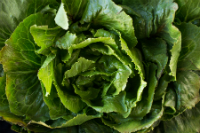APRIL 2017
WHAT’S NEW
PREVENT & REDUCE BACK PAIN NATURALLY
Back muscles attach to the spine, neck, shoulders, ribs and hips, which means that nearly every movement requires use of the very muscles designed to support and protect the spine. When we experience pain, it’s typically from a combination of factors: structural, lifestyle, work, stress, and previous or repetitive injuries.

For cooking, slice thin strips of the greens, rinse and drain; then proceed to steam or sauté. When adding chopped collard greens to a favorite vegetable or meat-based soup/stew, stir the steamed greens in during the final minutes of cooking. You can also add collard greens to spaghetti sauce or to a vegetable lasagna recipe, in place of spinach. For a flavorful side dish, sauté collard greens with yellow onions and fresh garlic (or shallots). For a zesty salsa, combine cooked collard greens with fresh tomatoes, onions, green peppers, and jalapenos.
FOOD FOR THOUGHT. . .
“Variability is the law of life, and as no two faces are the same, so no two bodies are alike, and no two individuals react alike and behave alike under the abnormal conditions which we know as disease.” – William Osler
IMPROVE YOUR HEALTH WITH COLLARD GREENS

For cooking, slice thin strips of the greens, rinse and drain; then proceed to steam or sauté. When adding chopped collard greens to a favorite vegetable or meat-based soup/stew, stir the steamed greens in during the final minutes of cooking. You can also add collard greens to spaghetti sauce or to a vegetable lasagna recipe, in place of spinach. For a flavorful side dish, sauté collard greens with yellow onions and fresh garlic (or shallots). For a zesty salsa, combine cooked collard greens with fresh tomatoes, onions, green peppers, and jalapenos.
RECIPE: SAUTEED COLLARDS & SPINACH
- 4 cups fresh washed collard greens (trim off the thick stems)
- 4 cups fresh washed spinach
- 1 tsp sunflower oil
- 6-8 cloves slices garlic
- 1/2 cup water
- 1/2 tsp salt
- 1/2 tsp pepper
- 1/2 fresh lemon or lime
- 1/4 cup olive or flax oil

MAGNESIUM: A MULTI-FACETED NUTRIENT

Here are just a few things magnesium can do for you:
- Calm your body by helping blood vessels dilate, which maintains lower blood pressure and makes it easier for the heart to pump blood.
- Improve quality of sleep, a critical defense against stress.
- Help neutralize stomach acid and move stools through the intestine.
- Play a role in lowering blood sugar, a major issue in diabetes management and prevention.
- Help with prevention and treatment of osteoporosis, nerve and back pain.
Food sources of magnesium include leafy vegetables, nuts, legumes, fish, fruits and whole grains. Because food levels of magnesium are affected by the quality of soil in which the food is grown, there have been huge declines in food-based magnesium content over the last few decades. Some people may be magnesium deficient and not realize that their symptoms of illness (e.g., headaches, muscle cramps, constipation) are related to insufficient magnesium.
There are different types of magnesium (e.g., citrate, glycinate) and various forms (pill, powder, liquid). Some forms may be better suited to different types of health issues. If you are concerned about magnesium deficiency due to dietary habits or physical symptoms, consult with your holistic practitioner to select the right type of magnesium supplement. Some forms of magnesium are poorly absorbed, so won’t provide therapeutic benefit, and other forms can cause changes in bowel movements. If you are interested in discovering which nutrients- vitamins, minerals and antioxidants your body is deficient in, take a look at this micronutrient level test.
REDUCE PAIN AND INFLAMMATION WITH DEVIL’S CLAW (Harpagophytum procumbens)

Devil’s Claw is available in tea and capsule form, as well as tincture and extract. Different forms are more suitable to different health concerns. Devil’s Claw is not recommended during pregnancy as it may stimulate uterine contractions. Also, Devil’s Claw can interact with other medications. It’s important to talk with your personal physician before taking this herb.
SOOTHE BACK PAIN WITH RESTORATIVE YOGA

Recent studies conducted in the U.S., India, and the U.K. showed that over a 6-12 month period, practicing yoga reduced pain and enhanced functional ability in people with chronic non-specific lower back pain. Those practicing yoga were compared to groups who did not exercise at all, which is common among people with back pain. In another large study in the U.S., people who practiced yoga in weekly 75-min. classes had better back movement, used less pain medicine, and participants with moderate back pain experienced a reduction in pain symptoms. Also, there is compelling evidence that yoga and similar mind-body practices not only change physical patterns in the body, but also change the brain gray matter patterns associated with chronic pain. The National Institutes of Health recognizes yoga and similar mind-body practices for their protective effects on the mind, brain, and body.
BACK PAIN REFERENCES
- National Institutes of Medicine “Prevention and Exercises for Your Back.” Reference Summary.
- American Chiropractic Association. Accessed 7 Feb 2016. “Back Pain Facts and Statistics,” “Joint Injury Prevention: Use It or Lose It”
- Green, Bart N et al. “Association Between Smoking and Back Pain in a Cross-Section of Adult Americans.”Ed. Alexander Muacevic and John R Adler. Cureus 8.9 (2016): e806. PMC. Web. 21 Feb. 2017.
- U.S. Institute for Health Metrics: Global Burden of Disease, various articles on back pain statistics can be found.
- Hoy D, March L, Brooks P, Blyth F, et al,. “The global burden of low back pain: estimates from the Global Burden of Disease 2010 Study.” Annals of the Rheumatic Diseases. 2014 Mar 24.
- NaturalNews.com “Top Remedies for treating chronic pain naturally.”
- Katzmarxyk, P. Lee, I. “Sedentary behaviour and life expectancy in the USA: a cause-deleted life table analysis.” BMJ (2012) 2:4 Accessed 7 Feb 2017.
IMPROVE YOUR HEALTH WITH COLLARD GREENS REFERENCES
- HealthyEating.SFGate.com “What are the health benefits of eating cooked collard greens?” Accessed 5 Feb 2017.
- WorldsHealthiestFoods.com “Collard Greens.” Accessed 5 Feb 2017.
- Nutritionandyou.com “Collard Greens nutrition facts.” Accessed 5 Feb 2017.
MAGNESIUM REFERENCES
- Mazur, A, Maier JA, et al., “Magnesium and the inflammatory response: potential physiopathological implications.” Arch Biochem biophys (2007) 458:1, 48-56. Accessed 3 Feb 2017.
- WorldsHealthiestFoods.com “Magnesium.” Accessed 3 Feb: 2017.
- NutritionalMgAssocation.org “Nerve and Back Pain Treated with Magnesium.” Accessed 3 Feb 2017.
- Appel, L.J., Brands, M. W., et al., American Heart Association. “Scientific Statement: Dietary Approaches to Prevent and Treat Hypertension.” Updated January 2014.
- Faloon, W. “Will Magnesium become the Next Vitamin D?” Life Extension (Dec 2016). 7-13.
- Davis, D.R. “Declining Fruit and Vegetable Nutrient Composition: What Is the Evidence?” Hort Sci (2009) 44:1, 15-19 Accessed 3 Feb 2017.
DEVIL’S CLAW REFERENCES
- Alternative Medicine Review: “Devil’s Claw: Monograph.” (2008) 13:3 Accessed 4 Feb 2017.
- Johnson, R.L., S. Foster, Low Dog, T. and Kiefer, D. National Geographic Guide to Medicinal Herbs: The World’s Most Effective Healing Plants. Washington, D.C.: National Geographic, 2012. 189; 216-219.
- Hoffmann, D. Medicinal Herbalism. The Science and Practice of Herbal Medicine. (2003) Rochester, Healing Art Press.
- University of Maryland Complementary and Alternative Medicine Database. “Devil’s Claw.” Accessed 4 Feb 2017.
- Pizzorno, Joseph E., Textbook of Natural Medicine. (2013). St. Louis, MO Elsevier. (chapter 174), 1475-1485.
- MedlinePlus.gov “Devil’s Claw.” Accessed 4 Feb 2017.
RESTORATIVE YOGA REFERENCES
- Wieland, L.S., Koetz, N. Pilkington, K. et al., “Yoga treatment for chronic non-specific low back pain.” Cochrane Library (Jan 2017) DOI: 10.1002/14651858.CD010671.pub2
- Sherman, K.J., Cherkin, D.C., et al., “A Randomized Trial Comparing Yoga, Stretching, and a Self-care Book for Chronic Low Back Pain.” Archives of Internal Medicine (2011) DOI: 10.1001/archinternmed.2011.524
- Brink, S. “Studies Show Yoga has Healing Powers.” National Geographic Online. (2014). Accessed on 7 Feb 2017.
- Carey, T.S., “Comparative Effectiveness Studies in Chronic Low Back Pain: Comment on ‘A Randomized Trial Comparing Yoga, Stretching, and a Self-care Book for Chronic Low Back Pain’.” Archives of Internal Medicine (2011) DOI: 10.1001/archinternmed.2011.519
- International Association of Yoga Therapists.
- American Pain Society. “Yoga and chronic pain have opposite effects on brain gray matter.” (May 2015) Accessed 2 Feb 2017.
- Ambrosini, Diane M., “Restorative Postures” as cited in Chapter 11: Instructing Hatha Yoga: A guide for teachers and students, 2nd ed. (2016). Human Kinetics: IL.
GUIDING PRINCIPLES

First Do not Harm

Identify and Treat the cause

Healing Power of Nature

Doctor as Teachers

Treat the Whole

Prevention is best Medicine
Follow us on instagram
BLOG
Become an educated consumer with our Indigo Blogs and prevent dis-ease.
Our Doctors have been featured in:









